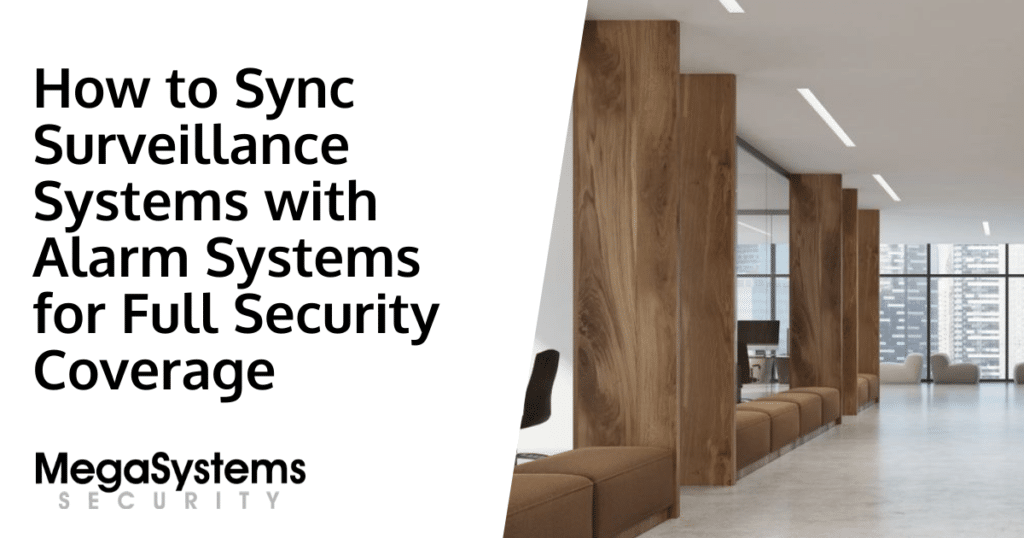Introduction
In today’s fast-paced world, achieving complete protection for your property requires many layers of defense. One effective strategy is syncing surveillance systems with alarm systems to create full security coverage. This process means connecting your surveillance cameras, which capture live images and footage, and your alarm systems, which alert you and the authorities when unusual activity is detected, into one seamless operational network. By integrating these two systems, property owners can achieve a robust level of security, reducing the response time to potentially dangerous situations and providing a comprehensive overview of events on-site.
Understanding the Components
Surveillance Systems and Their Functionality
A surveillance system typically consists of a network of camera units, wired or wireless, that work together to monitor activity in various areas. Each camera in the system is meticulously installed to cover specific zones, providing detailed images in real-time. The video recordings not only help in identifying intruders but also serve as valuable evidence for investigations. In surveillance systems, it is important to consider placement, quality of the camera lens, lighting, and field of view. A well-placed camera offers a broader perspective that enhances overall security by reducing blind spots and ensuring that every movement is captured from multiple angles.
Alarm Systems and Their Role
Alarm systems serve as an early warning mechanism when there is any unauthorized access or unusual activity. These systems often combine motion detectors, door sensors, and window contacts, and when triggered, send signals to both an onsite control panel and to monitoring centers. The connectivity between these devices allows for rapid response, often alerting safety personnel immediately. It is through these rapid alerts that an alarm system supports not only the prevention of ongoing incidents but also the deterring of potential intruders who know that a responsive system is in place.
Integrating Surveillance Systems and Alarm Systems
How Integration Works
Integrating surveillance systems with alarm systems means creating an interlinked network where both these systems share data in real time. For example, when a camera detects unusual movement or a person in a zone where they shouldn’t be, it can trigger the alarm system to activate lights, sound an alarm, or notify emergency response teams. This kind of integration ensures that every security breach is addressed instantly. The integration often requires compatible wiring and often digital connections or wireless communications. In addition, system software and interface synchronization ensure that alerts and video feeds are processed simultaneously, leaving no delay between detection and response.
How to Achieve Full Integration
To achieve full integration, property owners or security professionals must consider several steps. First, a detailed planning stage is necessary. During this phase, determining which areas need the most coverage is crucial. Then, you must select components that communicate effectively with each other. For instance, many modern systems incorporate protocols that allow both the alarm and surveillance components to connect wirelessly or over a network cable. Next, the physical installation must be carried out carefully; this can be done in a DIY fashion by experienced users or via professional installation services. Some regions, like houston and tx, are known for strict codes regarding commercial installation, requiring specific licenses and certifications. Understanding local guidelines and customs ensures that the installation is compliant and effective.
Benefits of a Synchronized Security Approach
Enhanced Monitoring and Faster Response
When surveillance systems and alarm systems are synchronized, the benefit becomes a faster response in the event of an intruder. This is achieved because the instant the camera sees suspicious activities, the alarm is activated, and authorities are alerted immediately. In this scenario, every second counts, and cutting down response time can make a significant difference in mitigating damage. The synchronization also allows individuals monitoring the system to review real-time footage while simultaneously checking the status of the alarm system, which increases overall situational awareness.
Comprehensive Data Collection and Analysis
Another advantage of having these systems work together is that it provides comprehensive data. Video footage captured during an incident can be analyzed along with the logs from the alarm system. This dual reporting can help identify the exact conditions under which a breach occurred. Data correlation assists in establishing patterns and improves future preventive measures. Moreover, such data can be used in improving the existing installation by identifying weak points where additional cameras or sensors should be installed for fortified security coverage.
Improved Efficiency and Reduced False Alarms
Integration reduces the frequency of false alarms since the system is calibrated to use multiple inputs before triggering an alert. When both the surveillance camera and the alarm sensor record correlated evidence of an intrusion, the probability of a false alert is significantly minimized. This improvement in efficiency not only enhances the trustworthiness of the system but also reduces unnecessary service calls and associated costs. The synchronization further benefits businesses by ensuring that notifications are not redundant or delayed, thus maintaining smooth operational processes in both residential and commercial environments.
DIY vs. Professional Installation
Weighing Your Options
One of the common challenges in integrating these systems is choosing between a DIY approach and a professional installation. DIY installations may appear cost-effective and immediate; however, they require a robust understanding of networking, wiring, and programming. The benefits of a DIY approach include the flexibility to make changes and the satisfaction of a self-managed project. Nevertheless, the risk of incorrect installation, non-compliance with local regulations, and potential system conflicts could lead to costly errors.
On the other hand, professional installation ensures that the system is set up correctly from the beginning, with all components—whether they are surveillance cameras, alarm sensors, or their communication modules—working harmoniously. In commercial zones such as those in houston or tx, professional installation might be mandated to meet local standards, ensuring that the entire system is reliable, safe, and legally compliant. Professionals have the expertise to adjust system settings and configure the integration so that the alarm system and surveillance systems work together flawlessly in every scenario.
Making the Right Choice
When deciding between a DIY installation and hiring professionals, one should consider the complexity of the areas that need coverage. For smaller properties or less complex setups, experienced DIY enthusiasts might appreciate the control over customization and installation costs. However, for larger properties or commercial settings that have higher security needs, professional installation ensures that every element is optimized and that the system remains future-proof and scalable. In either case, understanding the nuances of installation techniques, local regulations, and the interplay between different devices is critical to achieving a secure and reliable network.
Key Considerations for Comprehensive Security
Planning the Layout and System Integration
Before integrating your surveillance system with your alarm system, detailed planning should be conducted. This planning includes mapping out all vulnerable ingress points, planning the optimal placement for cameras and sensors, and establishing clear communication between the different components of the overall security system. Important factors include the type of camera used, whether they are bullet or dome types, and the relevance of their resolution and night vision capabilities to suit the environment being monitored. An effective system layout minimizes coverage gaps and ensures that both the alarm and surveillance devices are properly positioned for maximal effectiveness.
Understanding the Local Landscape
Different locations can dictate unique installation challenges. Houston and tx, for example, are notable for their urban environments where commercial security needs might differ significantly from residential ones. The surrounding architecture, local crime patterns, and even climate can affect the functioning of installation work and long-term equipment durability. Recognizing these local trends ensures that your security measures are not only state-of-the-art but also reliably resilient against the specific challenges faced in the area.
Choosing the Right Equipment and Software
Successful integration depends on selecting components that are fully compatible with one another. This means choosing cameras, sensors, alarm modules, and software platforms that are designed to delete delays in communication and enhance real-time alert capabilities. Many modern systems now offer integration packages that are pre-configured to streamline the connection between surveillance systems and alarm systems. These configurations ensure connected security by enabling centralized control centers where operators can monitor all security events at once. Therefore, investing in the right products and understanding the core functionality of each device are essential steps to ensure overall peace of mind.
Strategies for Long-Term Security Success
Continuous Monitoring and Maintenance
The integration of surveillance and alarm systems is not a one-time endeavor. Yes, the initial installation is critical, but continuous monitoring, regular testing, and proactive maintenance are equally important. Regularly checking cables, updating software, and testing sensors are vital steps that reaffirm the integrity of the system. These strategies ensure that all parts of the system remain fully operational and resilient, helping to prevent security breaches due to system malfunctions or outdated components.
Using Data to Enhance Future Protection
Once your integrated system is operational, you have an invaluable resource at your disposal: data. Recording past incidents, anomalies, and operational performance helps in identifying patterns and anticipating future security challenges. For instance, if certain cameras often capture insufficient footage due to environmental factors, adjustments in installation or technology may be necessary. Utilizing these actionable insights enhances the overall performance of the system and ensures that updates and refinements are made with a clear understanding of past trends and common challenges.
Adapting to Evolving Security Needs
Security technology is constantly evolving, and integrated systems are no exception. Newer technologies often offer better resolution, improved connectivity, and smarter analytics that allow for even faster and more accurate incident responses. As such, it is crucial to consider upgrade pathways and scalability in your current installation. The ability to adapt to future security demands, such as incorporating advanced artificial intelligence or cloud-based systems, ensures that your network remains at the forefront of comprehensive protection. Investors in both residential and commercial environments are increasingly embracing integration trends that offer not only current benefits but also future-proof security solutions.
Conclusion
Achieving full security coverage through the synchronization of surveillance systems with alarm systems is a complex, yet rewarding strategy. Whether you are looking in for a residential or commercial application, understanding the basics, planning meticulously, and selecting the right equipment and installation approach are the cornerstones of a robust security solution. By addressing detailed aspects like system integration, continuous monitoring, and scalability, property owners can ensure that their security measures are not only effective today but will adapt to future challenges as well. This comprehensive approach to security leverages both experienced insights and advanced technology, ensuring that every angle of protection is considered and every potential threat managed with the precision of modern surveillance and alarm systems.


